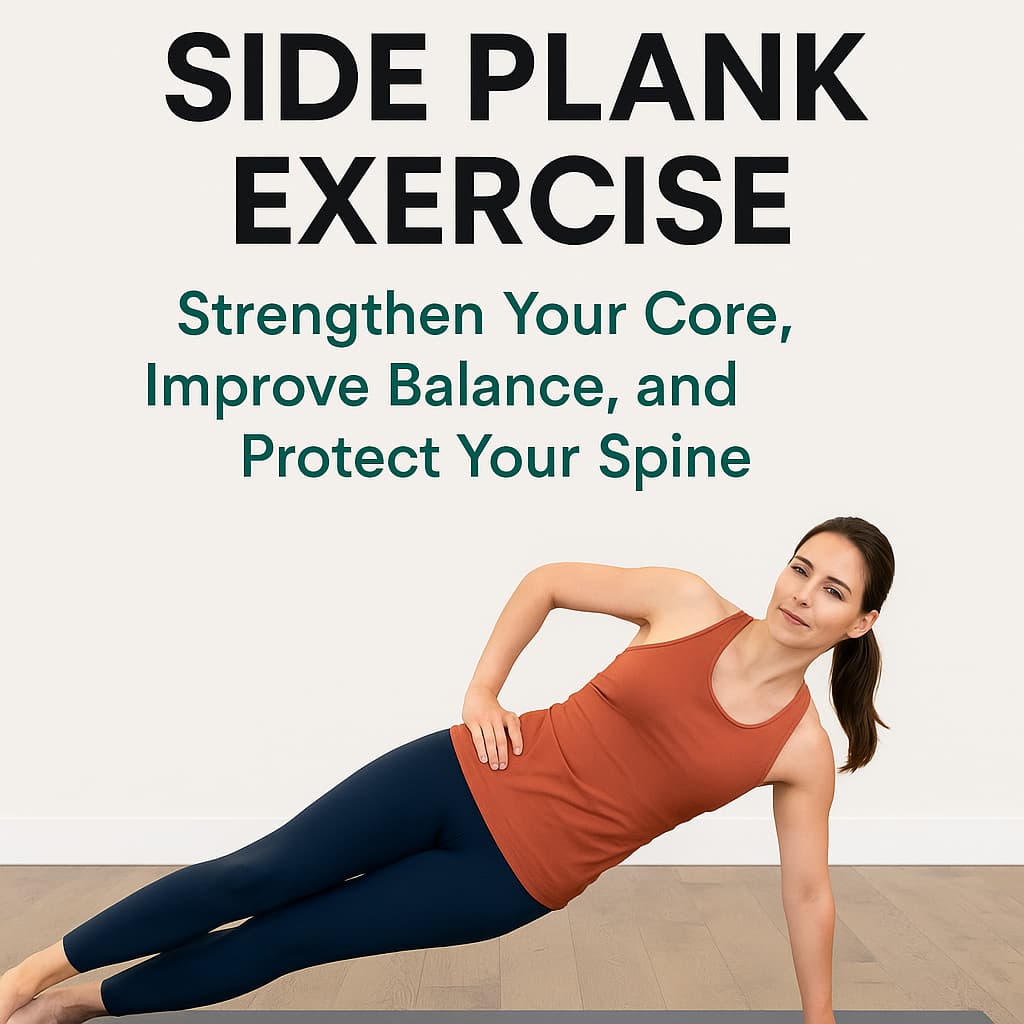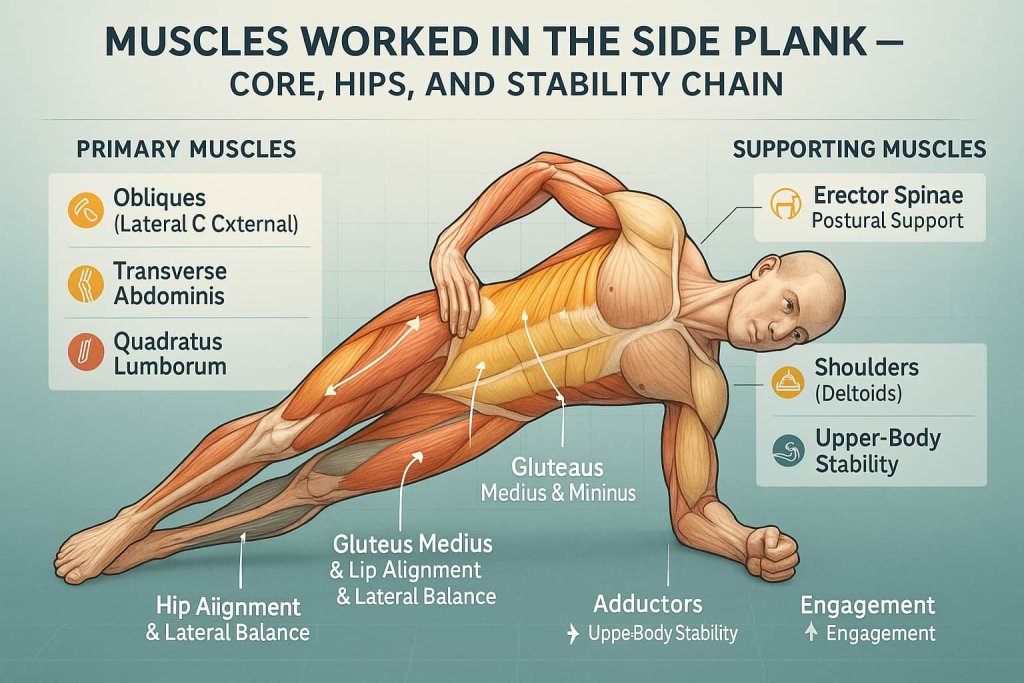The side plank is one of the most effective core exercises for building lateral stability, improving balance, and supporting spinal health. It targets the obliques and deep stabilizers of your torso, helping prevent back pain and improve posture.

Understanding how to perform and progress this move is essential for core strength and functional stability—especially if you sit for long periods, play sports, or want a lean, strong midsection.
What Is the Side Plank?
The side plank (or side bridge) is an isometric core exercise where you hold your body in a straight line, supported by one forearm and the sides of your feet. Unlike traditional planks, this variation emphasizes oblique and hip muscle engagement, training your body to resist lateral bending and rotation.
Why the Side Plank Works
The side plank strengthens your core stabilizers—muscles that protect your spine from collapsing or twisting under load.

Research shows the side-bridge/side plank produces high activation of the obliques and deep core, especially with abdominal hollowing, and that side-plank abduction variants greatly increase gluteus medius activity—important for hip and pelvic stability.
Benefits include:
- Builds core and oblique strength without spinal compression.
- Improves balance, posture, and coordination.
- Reduces risk of lower-back pain by stabilizing the lumbar region.
- Enhances athletic performance in running, lifting, and rotational sports.
- Requires no equipment—ideal for home or gym workouts.
How they work:
- Obliques & Transverse Abdominis: Stabilize the torso and prevent rotation.
- Quadratus Lumborum & Glutes: Keep hips elevated and aligned.
- Shoulders & Core: Support upper-body load and maintain posture.
How to Do the Side Plank (Step-by-Step)
- Start Position: Lie on your side with legs extended and feet stacked. Place your elbow directly beneath your shoulder.
- Lift: Engage your core and raise your hips so your body forms a straight line from head to feet.
- Hold: Keep your neck neutral and shoulders stacked.
- Breathe steadily—inhale through the nose, exhale through the mouth.
- Hold for 20–45 seconds per side, rest, then repeat for 2–3 sets.
Trainer Tip:
Avoid letting your hips drop. Imagine a straight line from your ear to your ankle. Keep tension through the glutes and obliques for full engagement.
Muscles Worked in the Side Plank

| Primary Muscles | Supporting Muscles |
|---|---|
| Obliques (internal & external) | Transverse Abdominis |
| Quadratus Lumborum | Gluteus Medius & Minimus |
| Erector Spinae | Shoulders (Deltoids) |
| Core Stabilizers | Adductors (inner thighs) |
Variations of the Side Plank
1. Modified Side Plank (Knees Bent)
Why it works:
Ideal for beginners or those with shoulder or lower-back discomfort, this version reduces body load while reinforcing alignment, oblique activation, and trunk stability.
Muscles worked:
- Obliques
- Transverse abdominis
- Gluteus medius
- Quadratus lumborum
How to do it:
- Lie on your side with knees bent at 90°.
- Place your elbow directly under your shoulder.
- Engage your core and lift your hips, forming a straight line from shoulders to knees.
- Hold for 20–40 seconds per side, breathing steadily.
Trainer Tip:
Keep hips stacked and spine neutral — avoid leaning forward or collapsing through the shoulder.
2. Side Plank with Hip Dips
Why it works:
Increases oblique engagement through controlled, dynamic motion and enhances muscular endurance.
Muscles worked:
- Internal and external obliques
- Transverse abdominis
- Gluteus medius
- Erector spinae
How to do it:
- Begin in a standard side plank position.
- Slowly lower your hips toward the floor, then raise them back to the start.
- Perform 8–12 reps per side.
Trainer Tip:
Move slowly with control — avoid bouncing your hips or twisting your torso.
3. Star Side Plank
Why it works:
Engages glutes, adductors, and outer thighs while improving total-body balance and shoulder stability.
Muscles worked:
- Obliques
- Gluteus medius and minimus
- Adductors
- Core stabilizers
How to do it:
- From a side plank, lift your top leg upward to hip height or higher.
- Keep hips lifted and body in a straight line.
- Hold for 10–20 seconds per side.
Trainer Tip:
Focus your gaze on a fixed point for balance and avoid letting your top hip roll forward.
4. Side Plank with Rotation
Why it works:
Challenges the core through rotational control, strengthening the obliques and transverse abdominis while improving thoracic mobility.
Muscles worked:
- Obliques
- Transverse abdominis
- Deltoids
- Quadratus lumborum
How to do it:
- From a full side plank, extend your top arm toward the ceiling.
- Slowly rotate your torso, threading the arm under your body.
- Return to start and repeat for 8–10 reps per side.
Trainer Tip:
Move smoothly and keep your supporting shoulder stable — avoid letting it collapse.
5. Weighted Side Plank
Why it works:
Adds external resistance to increase core endurance, hip stability, and muscular strength across the lateral chain.
Muscles worked:
- Obliques
- Quadratus lumborum
- Gluteus medius
- Shoulder stabilizers
How to do it:
- Hold a light dumbbell or small weight plate on your top hip.
- Maintain straight alignment from head to feet.
- Hold for 20–45 seconds per side.
Trainer Tip:
Keep the weight moderate — focus on maintaining perfect form rather than heavy resistance.
6. Side Plank with Leg Lift and Hold
Why it works:
Increases lower-body engagement and balance while activating glutes and inner thighs for hip stability.
Muscles worked:
- Obliques
- Gluteus medius and minimus
- Adductors
- Transverse abdominis
How to do it:
- In the side plank position, lift your top leg slightly above hip level.
- Hold for 10–15 seconds, then switch sides.
Trainer Tip:
Engage both glutes and keep hips stacked to prevent rotation or sagging.
7. Elevated Side Plank
Why it works:
Raising your forearm on an unstable surface increases balance demand and recruits more stabilizing muscles through the kinetic chain.
Muscles worked:
- Obliques
- Core stabilizers
- Shoulder stabilizers
- Gluteus medius
How to do it:
- Place your forearm on a step, foam pad, or BOSU ball.
- Lift into a side plank and hold for 20–30 seconds per side.
Trainer Tip:
Start with a low, stable surface before progressing to more unstable tools like a BOSU ball or balance disc.
8. Side Plank Pulse
Why it works:
Enhances endurance and strengthens the obliques through small, rhythmic movements that maintain constant tension.
Muscles worked:
- Obliques
- Transverse abdominis
- Gluteus medius
- Quadratus lumborum
How to do it:
- From a side plank, pulse your hips up and down about one inch for 15–20 seconds.
- Keep your core tight and movements controlled.
Trainer Tip:
Avoid large, jerky motions — the goal is to maintain steady tension and smooth rhythm.
Common Mistakes to Avoid
- Elbow not under shoulder: Causes shoulder strain.
- Sagging hips: Reduces muscle activation and stresses the spine.
- Holding your breath: Limits endurance.
- Twisting torso: Loses focus on obliques and stability.
Trainer Tip:
Film yourself or use a mirror to check alignment. Keep hips stacked and spine neutral throughout.
Safety & Precautions
The side plank is safe when done with proper alignment but can strain the shoulder or spine if performed incorrectly.
- Warm up first: Do light mobility (cat-cows, bird dogs).
- Elbow under shoulder: Prevents joint stress.
- Neck neutral: Avoid twisting or dropping the head.
- Modify if needed: Bend knees or shorten hold time if pain occurs.
- Medical note: Consult a doctor or physical therapist if you have back or shoulder issues.
Trainer Tip: Short, precise holds with good form are safer and more effective than long, sloppy ones.
How to Add Side Planks to Your Routine
- Beginners: 2 sets of 20–30 seconds per side.
- Intermediate: 3 sets of 30–45 seconds per side.
- Advanced: 3–4 sets of 45–60 seconds per side or with added resistance.
Frequency:
Perform 3 times per week, ideally after compound lifts or during your core circuit.
FAQs
1. How long should I hold a side plank?
Beginners can start with 20–30 seconds per side and gradually progress to 60 seconds.
2. Should I do side planks every day?
Every other day (3–4 times a week) allows for muscle recovery while maintaining strength gains.
3. Are side planks better than regular planks?
Both are effective—side planks target the obliques and lateral stabilizers, while standard planks focus on the front core.
4. What if my wrist or shoulder hurts?
Perform the side plank on your forearm or modify with your knees down to reduce pressure.
5. Do side planks burn belly fat?
They don’t directly burn fat but help tone and strengthen core muscles when combined with cardio and a balanced diet.
6. Can seniors or beginners do side planks?
Yes—use the knee-down variation for better stability and lower joint strain.
7. How can I make side planks harder?
Add hip dips, extend your arm upward, or hold a weight on your hip.
Conclusion
The side plank is a powerhouse exercise that trains your core, spine, and hips to work as one stable unit. It’s a simple move with huge payoffs—better posture, reduced back pain, and improved athletic performance.
Start with the basics, focus on form, and progress gradually.
For a strong and balanced core, make the side plank a staple in your weekly training routine.
References
- Youdas et al., 2014 — EMG during horizontal side support (side-bridge) (quadratus lumborum and abdominal wall activation)
Read on PubMed Central - Boren et al., 2011 — Gluteus medius EMG across exercises (side-plank abduction variants elicit very high GMed activation)
Read on PubMed Central - McGill et al., 1999 — Endurance times for core stabilization tests (benchmark side-bridge endurance; programming reference)
Read on PubMed - Juan-Recio et al., 2022 — Validity/reliability of the Side-Bridge Test (assesses lateral trunk endurance; testing guidance)
Read on PubMed Central - Petrič et al., 2022 — Trunk muscle endurance test characteristics (reliability and use of McGill-style tests incl. side-bridge)
Read on PubMed Central
Disclaimer
This content is for informational purposes only and does not constitute medical advice. Always consult a qualified healthcare or fitness professional before starting a new exercise program.
